All about fabrics

Knowing everything about fabrics, about what types of weaving textiles are, you can choose the most suitable option most correctly. It is very useful to study modal and other fabrics. A separate important topic is the main fabrics for clothing and the classification of artificial materials.


History of textiles
The very first synthetic fibers entered everyday life at the end of the 19th century. However, for many centuries and even millennia before that, natural fabrics confidently ruled the ball. Archaeological finds convincingly show that already in ancient times they began to take care of the production of clothing and materials for it. First of all, they began to use herbal stems, which they managed to apply with little or no processing. But these were only the forerunners of fabrics in the modern sense.
Real textiles (fibers of plants and animal hair) began to be used later. It is believed that handicraft textile production originated in ancient Egyptian times, about 7000 years ago. Then flax was widely used. After 1-2 thousand years, silk and cotton began to be used in Asia (respectively, they were introduced into circulation by Chinese and Indian cultures). Around the same time, or a little earlier, Middle Eastern craftsmen began to make woolen fabrics.


The latest archaeological discoveries, however, make it possible to significantly push back into the past the moment when textiles were first born. The oldest dated sewing needles were created about 50 thousand years ago. In many places they are found in layers 15 to 40 thousand years old. Ancient civilizations introduced an important improvement into practice - from purely manual preparation of fabrics they moved to the use of looms.The design of such devices remained practically unchanged, even in the Middle Ages, although some changes did occur.
It should be noted that much in the assessment of the ancient weaving culture depends on extraneous factors. The soils of China and the Middle East are conducive to the preservation of textiles, while in other regions, many samples simply did not have a chance to survive the centuries.

One thing is certain: in the 1st millennium BC, there were already a number of traditions for the production and use of fabrics in different places. During the Renaissance, woolen fabrics absolutely dominated in Europe, and only a few wealthy people could buy finer fabrics. At the same time, the design of more or less familiar today national costumes in different countries began (which is undoubtedly associated with the emergence of the nations themselves as a phenomenon).


A real breakthrough was associated with the emergence of a developed textile industry and its mechanization. These factors turned out to be even more important than the creation of a wide range of new dyes (or rather, without mass textile production, the same dyes would hardly have revealed their potential). The proliferation of productive sewing machines led to the fact that in industrial workshops they began not only to produce fabrics, but also to produce completely finished clothes from them. The development of chemistry as a science and the emergence of chemical synthesis made it possible to create a huge number of artificial fibers.
The spread of specific fabrics in the second half of the twentieth century began to obey fashion trends like never before. But it is still important to understand exactly what each type of fiber is, what its properties are.
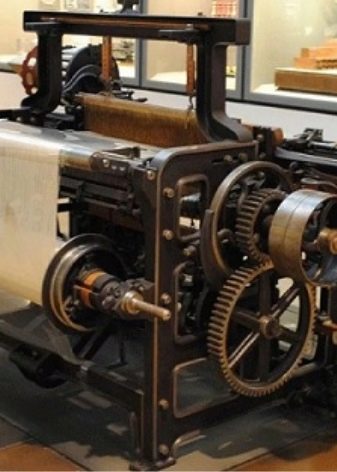

Types by composition
Natural
For a long time, as already indicated, the entire classification of tissues was limited to this section. And even in the 21st century, despite all the successes of chemists and technologists, natural substances are not going to become a thing of the past. The base in this case is mainly fiber:
- flax;
- silks;
- wool.
Cotton fabric is practical and comfortable. Many factories in different countries are engaged in its production.
Important characteristics are:
- softness and warmth;
- lack of electrification;
- suitability for repeated washing and ironing;
- strong resistance to sparks burning (very useful when working with a power tool);
- a number of other properties that are also valuable in workwear.


A material such as flax is also widely known. It is made by processing the stems of the plant of the same name. Linen fabrics are distinguished by their essential strength. They have a decent level of microventilation (in other words, they "breathe"). Basically, linen-based fabrics are painted in different gray and beige tones, they look emphatically natural.
Wool is the third in the top three among natural fabrics. The textile industry mainly uses sheep's wool, although there are exceptions. Woolen fabrics are prized for their softness and elasticity. The air permeability of wool is very high, but it still retains heat very well as long as it remains dry. Woolen fabrics are used to increase resistance to acids and high temperatures.


Modal is also a natural fabric. It is made exclusively from wood pulp. There is a one-sided and two-sided (denser) type of modal. It is in any case hygroscopic and comfortable matter. Air permeability and a high level of environmental friendliness can also be considered advantages.
Boston fabric is a type of woolen cloth. Boston outerwear is in high demand. Such products have only a few options for dark colors, including dark blue, and this is where its gamut is exhausted. But Boston:
- very durable;
- environmentally friendly;
- resistant to bacterial colonies;
- hygroscopic;
- it wipes a little over time (although it can be easily eaten by moths).


Synthetic
In this case, fibers obtained by the method of chemical synthesis are taken as a basis. A good example of a man-made fabric is polyester. This fiber is strong and resistant to moisture. It is possible to saturate and finish synthetic fabric without any problems. However, polyester is quite tough, absorbs static electricity too easily and is quickly burned by sparks - these problems do not allow it to be used as widely as possible.

Polyamide fibers are also represented by such popular options as nylon and nylon. Quality nylon products are sometimes thinner than the finest natural fabric. They are practically invisible, which is readily used by tights manufacturers. The widely demanded lavsan is also a modification of polyester. It is hygroscopic and relatively tough, but is often used as an additive to regular wool.
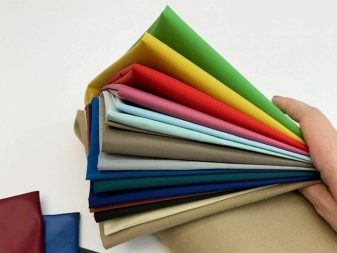

Also worth mentioning:
- polyurethane fabrics;
- polyolefin fabrics;
- acrylic;
- lycra;
- microfiber;
- fleece.

Mixed
In this segment, there are those matters that contain dissimilar fibers. For example, this is exactly what tisi belongs to. This fabric is based on cotton and polyester. The share of synthetic threads accounts for 65%, but in some cases their concentration rises to 80%. If the raw material is subjected to special impregnation, its density can reach 0.16 kg per 1 sq. m, visually tisi resembles, rather, coarse calico.
But the composition is not the only fabric characteristic worth paying attention to. Its texture is a very important parameter. Soft fabrics can be draped without problems and can fall into graceful folds. These are exactly:
- chiffon;
- silk;
- atlas.


Rigid fabrics have their advantages: they form crisper folds and are better suited for clothing with a strict geometric shape. Older versions of such products are taffeta and brocade. Newer ones are corduroy and denim. Transparent and matte fabrics are also distinguished by texture, and those that shine are placed in a separate category. It:
- crepe satin;
- atlas (translated from Arabic "smooth");
- various types of silk;
- organza;
- products with lurex.



What are the types of weaving?
The simplest solution is plain weave. It involves passing all the threads through one weft thread. Linen fabrics are economical and in demand. Linen products are rough and textured. Regardless of the presence of gaps, they are very dense and wear little.
On the basis of plain weaving, such popular products are created as:
- flannel;
- coarse calico;
- microfiber;
- poplin;
- linen.

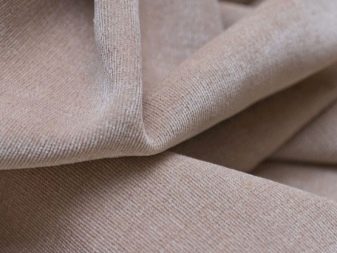
With a twill pattern, typical oblique stripes (“rib”) are found. There is one weft thread for at least 4 warp threads. This solution is very durable. It is the base fibers that predominate on the front surface. The diagonal angles are mostly 45 degrees, the twill practically does not wrinkle. Many people like shiny satin weave. The fibers are twisted very strongly.
The density of satin fabrics varies flexibly. It directly affects the consumer characteristics and the price of products. When the fabric is stained, the injected dye will hold up. On satin fabrics, the front edge is smooth, and a slight roughness is noted on the inside. The threads intersect infrequently - 1 through 5 or more. This solution is often used not only for natural, but also for synthetic fabrics.
Satin fabrics withstand abrasion. Possibly slipping during flooring and sewing, causing fabric distortion.
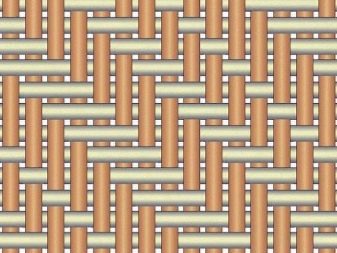
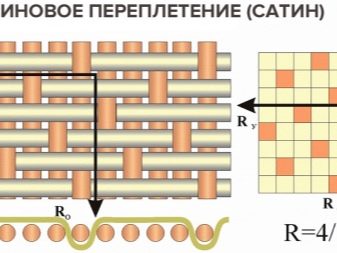
Varieties by purpose
The main types of fabrics listed above are used for ordinary clothing. But not all options are suitable for a medical uniform. The classic is cotton, which:
- not electrified;
- allows air to pass through;
- is inexpensive;
- hypoallergenic.

Along with it, tishi and satori are widely used. These blends are free from the disadvantages of pure cotton.They do not fade, they are very moisture resistant. Shrinkage of mixed materials almost does not occur. Technologists have learned how to produce such fabric with various styles and colors.
Denim or jeans are great for patchwork. They provide an excellent variety of shades. But in this version, sewing can also be used:
- viscose;
- linen;
- wool;
- thin cotton fabrics.

For bedspreads, they mainly use:
- cotton;
- bamboo;
- atlas;
- fleece;
- silk;
- tapestry.

We should also mention the printed fabric. Its peculiarity is the presence of a printed pattern. It can be formed both manually and using special machines. First of all, printed fabric began to be made in India. The following is mainly used as a basis:
- cotton;
- silk;
- linen;
- wool.

Any material can be supplied in rolls, regardless of type and purpose. This is done when sending bulk lots to customers. For sweatshirts, as well as for hoodies, sweatshirts and the like, they mainly use knitwear on a natural basis. Lycra or polyester can be added to the footer. Also used are:
- capitonium;
- ribana;
- kashkorse;
- fleece.

For bags apply:
- polyurethane;
- vinyl leather;
- morocco leather;
- gabardine;
- tapestry;
- suede;
- canvas;
- cordura;
- nylon;
- satin;
- taffeta.

Design options
Fabrics with a print can have an original appearance. They look more interesting than a monotonously colored product. The fabric with exquisite patterns is great for bags, clothes, and many other things. There are a lot of options for images, and all people can easily choose the most beautiful solutions for themselves. Coloring is done either by using pigments (classical approach) or by thermal printing.
Black fabric always looks stylish and attractive. It creates a hint of elegance and luxury more than any other textile color. This color is almost always appropriate, it is versatile.
It is believed that black clothing is slimming. But in fact, this effect is achieved only with proper cut and taking into account the optical laws.

White fabrics always look positive and fresh. There can be so many associations with them that it is simply impossible to list everything. The main thing is not to over-emphasize the white color, because then the wardrobe will look strange. It can make you feel overweight. But with a skillful approach, a fairly light wardrobe is obtained.
Green fabric is prized for its calming effect and visual harmonization. It is very important to avoid acidic shades, unless the goal is to annoy everyone who sees such suits as much as possible. Green color can express wisdom and complete self-confidence. White and green combinations are undoubted classics of design. You can also add black, you get a calm and not monotonous impression.
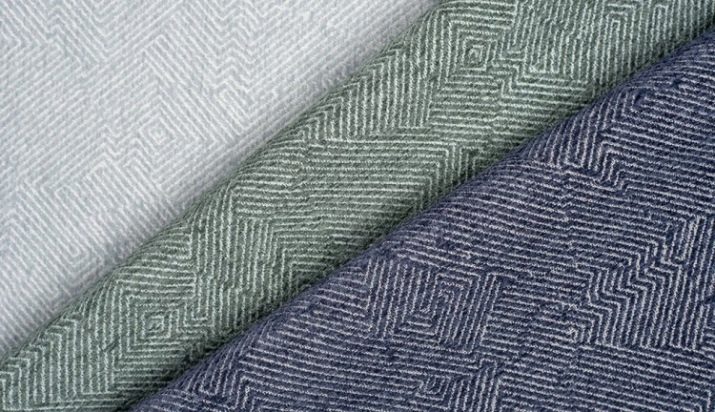
The yellow fabric is praised for its cheerfulness and positive attitude. She often emphasizes the creative nature of people. In the summertime, yellow fabrics look good, stylish, they do not warm up as much as dark products. With the onset of autumn and winter, they are valued for another reason - because of their ability to dispel monotony. This color allows you to focus on your sociability.
Some sources call the blue fabric "compromise", but this is not entirely accurate. In some cases, it is suitable for emphasizing romantic inclinations and travel cravings. It is also possible to emphasize your prudence and calmness. The blue and black range is ideal for a business suit.
In solemn situations, indigo color is more attractive.

Most of the controversy is caused by red tissue. She is able to impress and emphasize confidence, strength, authority. This is a kind of indicator of success. Red clothing is worn by experienced leaders and professionals.Excessive concentration of red tones can look aggressive.
Gray color can become basic or complementary to other colors. Variations in darker or lighter shades of gray are available to consumers. Orange fabric looks luscious and sunny. She helps, according to psychologists, to cope with apathy and despondency, gives vigor to the wardrobe. Saturated orange tones look ardent and energetic, while dark orange is always intense and calm.










